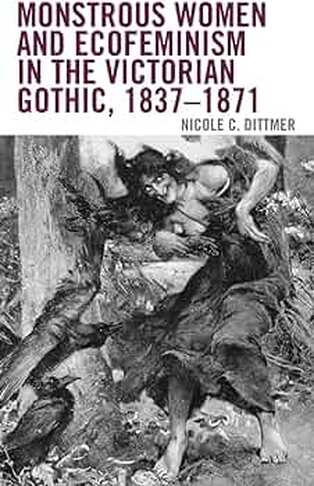
TITLE: Monstrous Women and Ecofeminism in the Victorian Gothic, 1837-1871
AUTHOR: Nicole C. Dittmer
PUBLISHER: Lexington Books
ISBN: 978-1666900798
PODCAST EPISODE: COMING SOON
REVIEWER: Hilary Wilson
Monstrous Women and Ecofeminism in the Victorian Gothic, 1837 - 1871 is Nicole C. Dittmer’s first monograph, published by Lexington Books. Previous studies of the Victorian Gothic have focused solely upon the monstrous within Gothic literature being figurations of the mind: physical manifestations of outward societal pressures. Dr. Dittmer’s work has taken a monistic stance viewing these monstrous characters as manifestations of physical and emotional concerns by relating them to contemporaneous ideas within science and medicine.
Dr. Dittmer is a scholar of Nineteenth-Century Gothic Studies and an adjunct professor at The College of New Jersey in Ewing, New Jersey. Her doctorate focuses on early-to-mid Victorian Gothic literature and contemporaneous medical sciences. Monstrous Women, an expansion of her dissertation, has considerable expertise behind it, which is sure to revolutionize the field of Gothic Studies through the monistic perspective of the monstrous feminine.
Over the course of the monograph Dr. Dittmer focuses upon a variety of familiar figures in Gothic Literature. Catherine Earnshaw, Mrs. Lovett, and Bertha Mason all grace the pages as she explains how the desire to domesticate the female sex within Victorian England was evidence of the conflicting views of the woman as both a ravenous sexual being and a nurturing Mother brought into existence by the Divine for no purpose but childbearing. These conflicting identities are presented through diagnoses of conditions such as Hysteria, as well as reflected within the landscape itself - the female sex often caught in the liminal state between civilization and the Wild.
By explaining the contemporaneous science within the text, she is able to elaborate on the conditions that readers of the day would have recognized in the various literary figures. Is Mrs. Lovett destined for criminality by virtue of her class or physiognomy? Phrenology places her within the criminal class, but her very sex posits that she wish for something better - it is the fracture that results from these warring desires that allows her a tragic affect.
The crowning jewel within the monograph that offers the best explanation of what Dr. Dittmer posits are the she-wolves of Gothic Literature. Whether a wolf made human, or a human bedding a werewolf, they represent the consummation of civilization and wilderness, criminality and nurture in all of its tragic results. Dr. Dittmer’s monograph is a fascinating read, replete with references for further reading and food for thought. This monograph will allow Gothic literature to be read in a new light and provide fascinating analysis for years to come.
AUTHOR: Nicole C. Dittmer
PUBLISHER: Lexington Books
ISBN: 978-1666900798
PODCAST EPISODE: COMING SOON
REVIEWER: Hilary Wilson
Monstrous Women and Ecofeminism in the Victorian Gothic, 1837 - 1871 is Nicole C. Dittmer’s first monograph, published by Lexington Books. Previous studies of the Victorian Gothic have focused solely upon the monstrous within Gothic literature being figurations of the mind: physical manifestations of outward societal pressures. Dr. Dittmer’s work has taken a monistic stance viewing these monstrous characters as manifestations of physical and emotional concerns by relating them to contemporaneous ideas within science and medicine.
Dr. Dittmer is a scholar of Nineteenth-Century Gothic Studies and an adjunct professor at The College of New Jersey in Ewing, New Jersey. Her doctorate focuses on early-to-mid Victorian Gothic literature and contemporaneous medical sciences. Monstrous Women, an expansion of her dissertation, has considerable expertise behind it, which is sure to revolutionize the field of Gothic Studies through the monistic perspective of the monstrous feminine.
Over the course of the monograph Dr. Dittmer focuses upon a variety of familiar figures in Gothic Literature. Catherine Earnshaw, Mrs. Lovett, and Bertha Mason all grace the pages as she explains how the desire to domesticate the female sex within Victorian England was evidence of the conflicting views of the woman as both a ravenous sexual being and a nurturing Mother brought into existence by the Divine for no purpose but childbearing. These conflicting identities are presented through diagnoses of conditions such as Hysteria, as well as reflected within the landscape itself - the female sex often caught in the liminal state between civilization and the Wild.
By explaining the contemporaneous science within the text, she is able to elaborate on the conditions that readers of the day would have recognized in the various literary figures. Is Mrs. Lovett destined for criminality by virtue of her class or physiognomy? Phrenology places her within the criminal class, but her very sex posits that she wish for something better - it is the fracture that results from these warring desires that allows her a tragic affect.
The crowning jewel within the monograph that offers the best explanation of what Dr. Dittmer posits are the she-wolves of Gothic Literature. Whether a wolf made human, or a human bedding a werewolf, they represent the consummation of civilization and wilderness, criminality and nurture in all of its tragic results. Dr. Dittmer’s monograph is a fascinating read, replete with references for further reading and food for thought. This monograph will allow Gothic literature to be read in a new light and provide fascinating analysis for years to come.